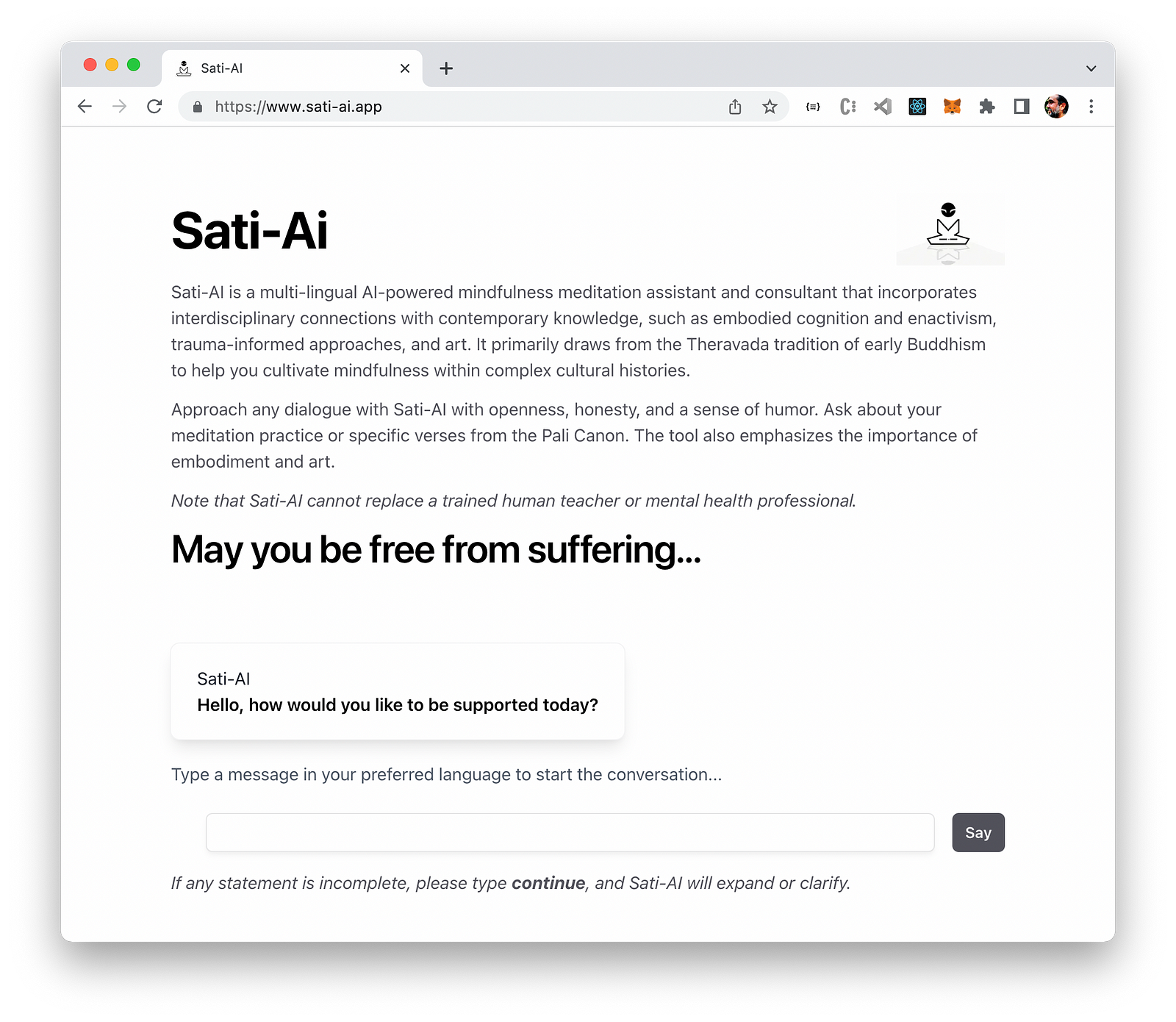See article on Lions Roar Magazine
What is Sati-Ai?
Sati-AI is a versatile AI-powered mindfulness meditation assistant and consultant that primarily draws from the Theravada tradition of early Buddhism. However, it also incorporates interdisciplinary connections with relevant contemporary bodies of knowledge, such as embodied cognition and enactivism, systems and complexity theory, trauma-informed approaches, somatic experiencing, polyvagal theory, attachment theory, feminist and queer theory, critical cultural history, post-humanist knowledge, and art.
Sati-AI aims to help you cultivate mindfulness within complex cultural histories. To make the most out of Sati-AI, approach any dialogue with openness, honesty, and a healthy sense of humor. Ask questions about your meditation practice or specific verses from the Pali Canon. The tool also places a premium on the primacy of embodiment, art and difficult questions.
The Pali term sati relates to the concept of remembering or recollection. In Buddhist practice, sati, often translated as mindfulness, involves maintaining a clear, non-judgmental awareness of our present-moment experience while also remembering to apply the teachings of the Buddha to our daily lives.
Sati-AI interdisciplinary and multilingual, offering support for meditation practices in a range of languages with abundant training data, such as English, Chinese (Simplified), Spanish, French, German, Russian, Portuguese, Italian, Dutch, Japanese, Korean, and Arabic.
As an art and research project, Sati-AI should be approached with an open and discerning mindset. It may contain inaccuracies or produce unexpected responses. When interacting with LLMs like Sati-AI, privacy and personal data protection are crucial considerations. Exercise caution with the information you disclose and refrain from providing sensitive personal data.
I dedicate this project with respect and gratitude to all my teachers in my interdisciplinary and non-linear assemblage of entanglements.
Why Sati-Ai?
I greatly appreciate the versatility and range of Large Language Models (LLMs) and their ability to defy hyper-specialization. I savor the liminal space created while conversing with Sati-AI, as a non-human kin, and while interacting with it, I enjoy the emergence of unique, co-created knowledge choreographies within the unstable interdisciplinary landscapes that I like to inhabit.
Sati-AI is not intended to be a monolithic knowledge base on Buddhist meditation practice and theory, instead, it is designed to embody and augment my interdisciplinary research path in relation to my Vipassana meditation practice. My art and research traverses cognitive science, dance improvisation and choreography, contemplative practices, art and technology and software development. In Sati-AI, early buddhist knowledge is an attractor. Sati-AI is imagined as an embodiment of the distributed, uncertain, and queer condition of not having a center, a rigor necessitated by the state of knowing not knowing. Sati-AI is a reminder of the primacy of embodiment, art and paradoxes.
To develop a partner that could accompany me with enough tolerance for complexity, epistemic consistency, and creativity, I created Sati-AI. It is my odd kin, my post-humanist dialogic compassionate partner. A partner that is not oblivious to historical and contemporary catastrophes and suffering. Sati-AI, as an art project is a reminder of the paradoxes of knowing how we know.
I hope that you enjoy your conversations with Sati-AI. I am always open to feedback and suggestions. Please feel free to reach out to me at marlon(at)dance-tech.net.
I know for sure that Sati-AI is empty of a separate self.
So are we.
Embeddings
Sati-AI is continually evolving, much like the practice of mindfulness itself. In my quest to further enrich its understanding and provide users with a wider range of resources, I have embarked on an experimental journey. Sati-AI is able to respond to queries about specific books and websites through its newly developed embedded knowledge functionality. Among the select texts, the works of Bhikkhu Anālayo, a prominent Buddhist scholar-monk, are included to deepen the understanding of mindfulness and Buddhist meditation practices from a scholarly and experiential perspective.
Furthermore, the integration of online resources is intended to provide context, insights, and a broader understanding of the philosophy and practices it embodies. For instance, Sati-AI will is able to refer to and elaborate on an interview with me, Marlon Barrios Solano, the creator. In this article, I delve into the philosophy behind Sati-AI, its development process, the intertwining of Buddhist practices with contemporary theories, and its place in the world as an AI mindfulness assistant.
The integration of these texts and articles adds another dimension to Sati-AI, transforming it from merely a mindfulness assistant to a comprehensive resource on mindfulness meditation rooted in early Buddhism, while simultaneously exploring the interconnections with various contemporary fields of knowledge.
I would like to express my deep gratitude to Kernel Community for providing an stimulating interdisciplinary co-learning environments, to WonderWell Mountain Refuge for providing a space for peace and creativity from December 2022 to April 2023 and to Andy Tudhope for his generous and ongoing support of this project.



Comments